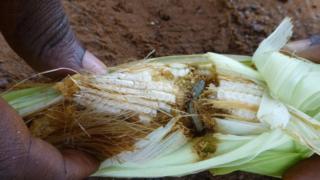
Scientists warn that parts of southern Africa already hit by record droughts now face another potential food crisis because the invasion of a crop-eating pest, known as the "fall armyworm".
Global experts are meeting in the Zimbabwean capital Harare to come up with a plan to combat it.
What is the fall armyworm?
The name is a bit misleading. It is not actually a worm, but a hungry caterpillar that eats crops before turning into a moth.
It is a new pest, not to be confused with the similarly named "African armyworm", which has been present in the region for many years.
Where did it come from?
It is native to the Americas, but experts are not sure how it reached Africa.
One theory is that the eggs or the caterpillars themselves hitched a ride in some imported produce, or even made it on board commercial flights.
Why is it such a threat to farming?
- It is very hungry (and not picky) - This pest targets maize (corn) and other cereal crops, like its African namesake, but it also attacks cotton, soybean, potato and tobacco crops. When it does invade, up to three-quarters of the crop can be destroyed.
- Unknown enemy - Governments, communities and farmers have no previous experience of dealing with the new pest, which may be even harder to deal with than its native equivalent.
- It is fast - According to the UN's Food and Agriculture Organisation (FAO), it has taken only eight weeks for the pest to spread to the six southern African countries where there are suspected infestations.
- It travels far and wide - The caterpillar stage does the damage but "it's the adult moth that migrates long distances and that's how it's managed to get round Africa," says Professor Ken Wilson, an expert on armyworms.
- It is not just targeting any old crop - Maize is the primary food staple in many of the areas where the pest has been identified.
- It is hard to find - The fall armyworm burrows right into the stem of maize plants, concealing itself from view and preventing farmers from spotting the problem early.
- Bad timing - It comes after two years of record droughts, which have already affected more than 40 million people in the region, making 15% less food available, according to the UN.
Where is it?
South Africa, Zimbabwe, Malawi, Zambia, Namibia and Mozambique are the chief suspects among southern African countries, according to the FAO.
The presence of fall armyworm in Africa was first reported on the island nation of Sao Tome and Principe in January 2016, it says.
Chimenya Phiri, Malawian farmer:
"These army worms attack the maize leaves, the flower and even bore into the stalk. And because they dig into the stem of the plant, it is difficult to notice them. It is only on close inspection that you realise almost the entire plant has been destroyed"
Other research groups have also reported it in parts of West Africa, including Nigeria and Ghana.
But the governments of Zimbabwe and South Africa are the only ones to have publicly confirmed that they have a problem with this specific pest.
How much damage has already been done?
We don't know exactly, because many affected countries have not provided data yet.
Finding out the number of hectares affected and the intensity of the pest is one of the main aims of the emergency summit in Zimbabwe, the UN says.
South Africa, the region's biggest maize producer, has confirmed the destruction of crops from the pest in six different provinces.
The Zambian government has said that 130,000 hectares (321,236 acres) of land have been affected, with the prime suspect the fall armyworm.
What can be done to stop it?
Insecticides. Chemicals can be used to deal with the pest in its early stages, but after that it becomes much harder, and some populations of fall armyworm have developed resistance, according to experts.
Other approaches involve digging trenches, employing natural predators, like birds, to eat the worms or even burning the crops, according to David Phiri, the senior FAO official in southern Africa.
Zambia, thought to be one of the first places hit by the outbreak, used army planes to spray affected areas with insecticides, which has enabled some crops to recover, an official at the national disaster agency told the BBC.
What next?
The warning from the FAO is a bleak one, suggesting that things will probably get worse before they get better.
"It has just started - even those countries not currently affected should prepare themselves for possible infestations," Mr Phiri told the BBC.
Scientific institutes have also raised the alarm, describing the pest as a major threat to food security and agricultural trade in the region.
However, if there is a "co-ordinated approach" from countries across the region, then that's where the solution might lie, Mr Phiri says.
"We cannot eradicate it, but we can find ways of managing it."
 |
| Un affected maize close to harvest |
No comments:
Post a Comment